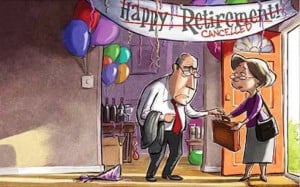
Introduction
The holiday gift buying season is over. Next month the credit card bills will be arriving. Maybe you overspent on holiday gifts this year. Maybe you had too much debt to start with, and you know this new spending will put you over the top. Perhaps you already have questions about Canadian bankruptcy and insolvency law.
Perhaps you spent wisely but modestly because you were acutely aware of your financial problems. Maybe you never were an uncontrollable spender. Perhaps a specific damaging event outside of your control caused you to wind up deep in the red. So far you have worked hard to overcome the financial challenges, but for the first time you are thinking that you should read up on Canadian bankruptcy and insolvency law.
Either one unfortunate life issue or one foolish monetary choice is all it could take. Despite how you arrived, there is no simple escape, except perhaps winning the lottery or an unexpected inheritance.
Bankruptcy is one alternative
If you’ve fallen under just what seems like impossible financial debt and you have no chance to get out of it, bankruptcy is one alternative. It’s not constantly an excellent one– and never ever one to be taken gently.
Below is exactly what you should understand prior to making any kind of choices about filing personal bankruptcy.
Long-term results
Almost 63,372 people declared bankruptcy in 2016, an action that will certainly have an effect on them for a long time to come. They have certainly started learning about the Canada bankruptcy and insolvency law regime.
While declaring bankruptcy relieves debt pressures caused by decisions and/or issues of the past, it could adversely influence your future. The record of your filing for bankruptcy will certainly stay on your record for up to 10 years.
Numerous companies run a credit check on job applicants. The record of your bankruptcy will come up. Potential employers have either their own bias or unique interpretation about this. Perhaps the job you are applying for requires you to be bonded. Faced with many qualified applicants, a potential employer may very well choose the person who does not have a bankruptcy on their record. As I have previously written, it can likewise have an influence on insurance coverage costs.
The Canadian bankruptcy and insolvency law system is designed to financially rehabilitate the honest but unfortunate debtor. As a licensed insolvency trustee, I certainly believe in our system. However, it is also my role to point out to anyone considering personal bankruptcy, there are many issues to consider before taking this choice.
Evaluating your alternatives
For some people bankruptcy many not be the only option. Just how do you recognize its the right one for you? What are the options under Canadian bankruptcy and insolvency law?
Prior to making any type of choice about filing for bankruptcy, you should first contact a licensed insolvency trustee (LIT) in your area for a free consultation. The LIT will review with you your current financial situation and ask you various questions. The purpose is for the LIT to gain an understanding of your current financial position and how you got there. Based on this information, the LIT will be able to give you a preliminary opinion about what your realistic options are.
In general, the options available to someone experiencing difficulty in paying their debts on time include: (i) credit counselling; (ii) debt consolidation; (iii) (consumer) proposal; and (iv) personal bankruptcy.

The proposal option used for half of all personal insolvency filings in 2016
I am using brackets around the word “consumer” when talking about the proposal option. A consumer proposal is available to anyone who owes the amount of $250,000 or less, not including the amount you owe on loans registered against your home. If you owe more than this $250,000 threshold, a proposal may still be the most viable option for you. That proposal process just falls under a different section of the Bankruptcy and Insolvency Act (Canada) (BIA). It is not called a consumer proposal, but rather a Division I proposal. The BIA governs Canadian bankruptcy and insolvency law.
As I mentioned above, in 2016, 63,372 Canadians filed personal bankruptcy. However the total number of people who filed an insolvency proceeding in 2016 in Canada was 126,843. So what did the other 63,471 people do? They filed a proposal. So roughly half of the people who filed an insolvency proceeding in Canada in 2016 to solve their debt problems, were able to avoid bankruptcy.
In 2016, 63,471 individuals filed a (consumer) proposal. This bankruptcy alternative is an organized settlement of your financial debts for an amount less than the total you owe. You can take up to 60 months of regular monthly payments to complete your (consumer) proposal.
The proposal provisions of Canadian bankruptcy and insolvency law allow those people “in the red” to keep their assets they can afford to continue paying for, including their home. At the same time, they made a monthly payment to the LIT to be distributed to their creditors for their past debts that they could not afford to repay.
Canadian bankruptcy and insolvency law: Beginning the insolvency filing process
If you believe that bankruptcy may be for you, your first action is to speak with a LIT. Remember, you are not only looking to them for solutions. The LIT is not only interviewing you. You are also interviewing the LIT to decide if this is someone you feel you can work with.
If you don’t feel comfortable after speaking to that first LIT, there is nothing wrong with you getting a second opinion from a different LIT. Not only is that not anything wrong with that, I urge it. You are going to be working with your LIT for quite some time. Make sure that you believe it will be a comfortable relationship for you.
The bottom line is if you got in over your head with money, you do have alternatives. Get an expert viewpoint on just what your options might be under Canadian bankruptcy and insolvency law. If you can’t make your monthly payments, you need professional help; and you need it now. Contact a professional Toronto bankruptcy trustee.
The Ira Smith Team has a cumulative 50+ years of experience helping people who are facing a financial crisis and we deliver the highest quality of professional service. Make an appointment for a free, no obligation appointment today and Starting Over, Starting Now you’ll take your first steps towards financial freedom.
We wish all of our readers and subscribers a healthy, happy and prosperous New Year 2018.








